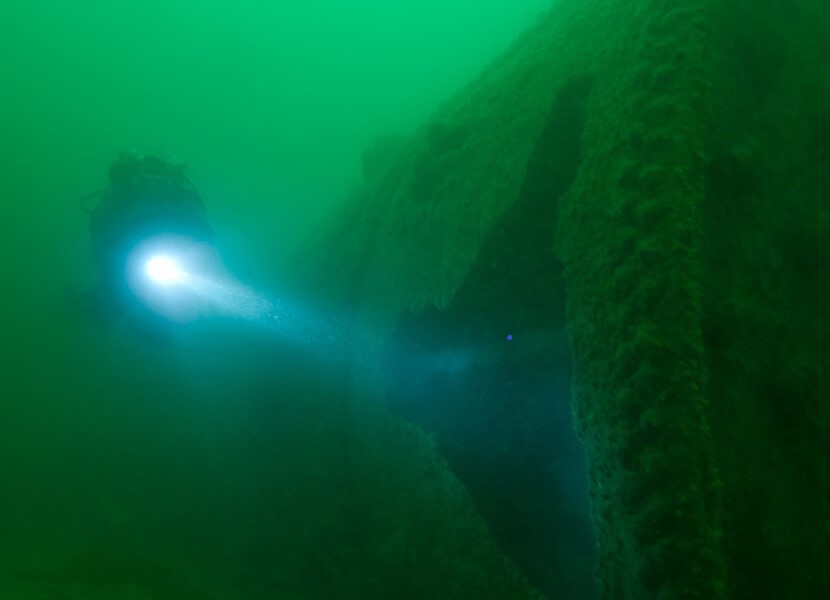18 February 2022
Remembering the sinking of the SS Mendi 105 years on
This year marks the 105th anniversary of the second largest loss of South African lives during the First World War. Will Reid uncovers the story of the SS Mendi and the tragic sinking of the ship which occurred in the early hours of 21st February 1917, 20km south of the Isle of Wight.

From cargo to troop transport

The SS Mendi
The SS Mendi was first launched on the River Clyde in Glasgow, Scotland in 1905. Weighing more than 4,000-tonnes, this steamship was owned by the British and South African Steam Navigation Company and was used to move cargo and mail between Liverpool and West Africa. Then in autumn of 1916, the ship was contracted by the British Government for wartime service and underwent adaption so it could transport troops and cargo to support the armed forces.
The Foreign Labour Corps
As the First World War progressed and casualties remained high, the need for labour units to keep the army supplied and free up men for front line service was such that Labour Corps were established.
These Labour Corps initially drew on regiments in the British Army; however, it was soon recognised that the army needed to turn to its Empire to fill the gaps. By the end of the war over 300,000 men from across the Commonwealth had joined the Labour Corps, 70,000 of whom served with the SANLC.
The first contingent of SANLC to arrive in France, on 20th November 1916, was composed of around 1,500 men. Over the course of the next three months, a further four contingents followed, bringing the total strength up to around 8,000 by the end of January 1917.
The Fate of the SS Mendi
Leaving Cape Town on 25th January 1917, those aboard the SS Mendi were also destined for France. It made stops en-route at Lagos in Nigera, then Freetown in Sierra Leone, taking on cargo and supplies before making its final stop in Plymouth, England on 19th February 1917. The following day that she sailed for France accompanied by the destroyer HMS Brisk for protection against German U-Boat Submarines. Both set sail into the English Channel in complete darkness.

The SS Mendi's final journey, © Wessex Archaeology
Whilst the sea was calm, the presence of thick fog made it extremely difficult to see ahead. At 4:57am, when both ships were around 20km from the Isle of Wight the SS Darro, a ship twice the size of the SS Mendi, suddenly appeared out of the fog sailing at full speed straight for the Mendi. With no time to adjust course, the Darro collided with Mendi’s right side, forcing it to lean as it rapidly took on water which prevented the lifeboats on that side of the ship from being deployed. What made matters worse was that SS Darro didn’t even stop to help.
 With only half of its lifeboats in the water, the situation for its passengers and the men of the SANLC became desperate. For many onboard it was their first time at sea. Amongst the disarray was the calm head of the Revered Isaac Wauchope Dyobha who, as the story goes, ordered the men to form ranks on the deck so he could lead the ‘Death Dance’, addressing them with the following words:
With only half of its lifeboats in the water, the situation for its passengers and the men of the SANLC became desperate. For many onboard it was their first time at sea. Amongst the disarray was the calm head of the Revered Isaac Wauchope Dyobha who, as the story goes, ordered the men to form ranks on the deck so he could lead the ‘Death Dance’, addressing them with the following words:
Be quiet and calm, my countrymen, for what is taking place is exactly what you came to do. You are going to die, but that is what you came to do. Brothers, we are drilling the death drill. I, a Xhosa, say you are my brothers. Zulus, Swazis, Pondos, Basothos and all others, let us die like warriors. We are the sons of Africa. Raise your war cries my brothers, for though they made us leave our assegais back in the kraals, our voices are left with our bodies.
Image left: Reverend Isaac Wauchope Dyobha
HMS Brisk, supported by other ships nearby, rescued what casualties it could and returned to England with the survivors. Around 650 men did not return.
The legacy of the SS Mendi
In Southampton, CWGC’s Hollybrook Memorial to the Missing is inscribed with the names of over 600 men of SANLC that lost their lives on SS Mendi, who have no known grave. As you walk along the panels reading each name, you can begin to grasp the scale of loss. What it can’t convey though is the impact felt by the families and communities these men left behind when they boarded the SS Mendi.
Whilst most are commemorated on the Hollybrook Memorial, there are around 20 casualties whose bodies were washed ashore and buried in cemeteries across the coast of England, the Netherlands and France. All of these casualties are cared for by the Commonwealth War Graves Commission.

As for the wreckage of the SS Mendi, it remains at the bottom of the English Channel. On numerous occasions it has been visited by divers, yet it was only correctly identified in 1975 when a plate was recovered bearing the crest of the British and African Steam Navigation Company. Since then, more artefacts have been recovered and are now displayed in Museums located in Cape Town, Port Elizabeth, and the Isle of Wight.
As interest in this extraordinary story grew, funding in 2007 from English Heritage and the South African Resources Agency allowed Wessex Archaeology to undertake a geophysical survey of the wreck. This was an opportunity to assess the ship’s condition using specialist equipment to produce a 3D profile and confirm how much of the wreckage remained intact.
Upon reaching the wreckage, it was clear it had undergone substantial change in recent years. The bow and stern of the ship would have once been prominent upstanding features but have since collapsed, as has the centre of the ship where the boilers and engine can be clearly seen.
Image left: One of the may artefacts discovered at the SS Mendi's final resting place, © Wessex Archaeology.
Features such as the main and foremast however were still visible, and large parts of the hull remained intact with much of the internal superstructure. Investigations such as this are crucial not only to assess the condition of the ship and to understand how it can be best protected, but to fill in the gaps in history of its final moments at sea. In 2015, it was officially designated as a protected wreck by the Ministry of Defence, making it an offence for any licensed diver to damage or remove any artefacts.
On an annual basis, remembrance services are held around the world to acknowledge the sacrifice the men of the SANLC made. In Cape Town, memorials in Avalon Cemetery in Soweto and on the campus of the local university are regularly attended. Further afield in the Netherlands, people gather in Noordwijk Cemetery, as they do in cemeteries such as Portsmouth and Littlehampton in England.
In his final words, Revered Isaac Wauchope Dyobha encouraged his men to ‘raise your war cries my brothers’. Today, on the 105th Anniversary, we too must raise our own voices and continue to tell the story of the SS Mendi to ensure the men of the SANLC and their sacrifice is never forgotten.








